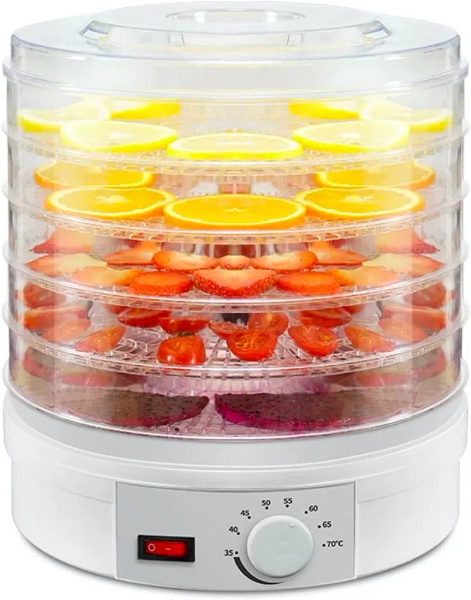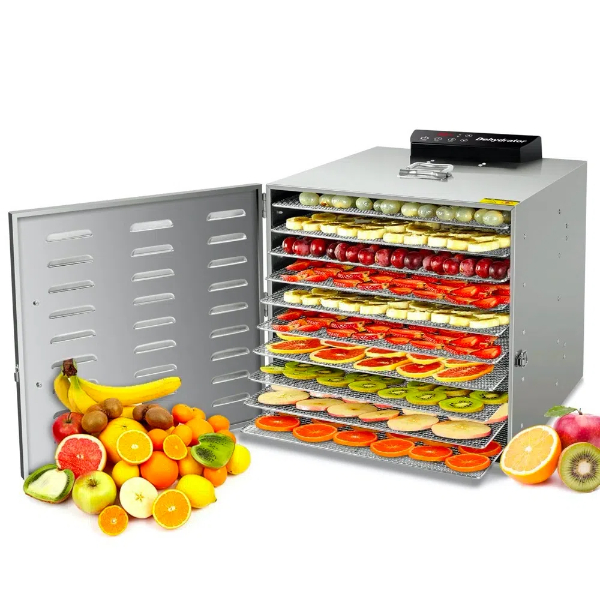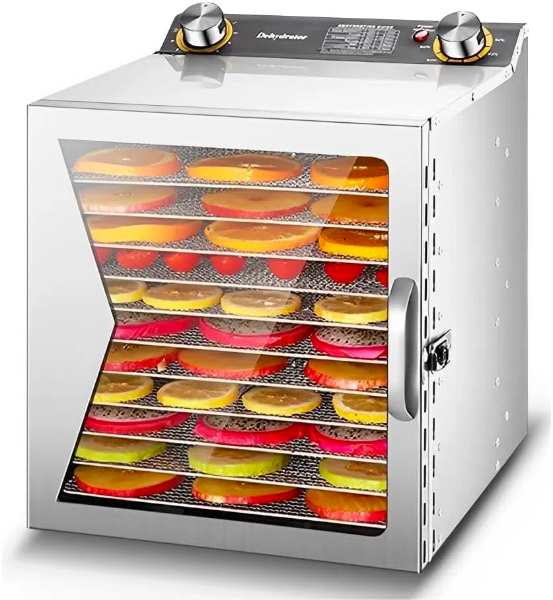
Content Menu
● Introduction to Fruit Dryer Machines
● Understanding the Technology Behind Fruit Dryer Machines
>> Key Components of a Fruit Dryer Machine
● Benefits of Using a Fruit Dryer Machine
>> 1. Preserves Nutritional Value
>> 2. Extends Shelf Life
>> 3. Creates Healthy Snacks
>> 4. Versatility
>> 5. Cost-Effective
● Choosing the Right Fruit Dryer Machine
>> 1. Size and Capacity
>> 2. Temperature Control
>> 3. Airflow Design
>> 4. Noise Level
>> 5. Additional Features
● Popular Fruit Dryer Machine Models on Amazon
● Tips for Using Your Fruit Dryer Machine Effectively
● Creative Uses for Your Fruit Dryer Machine
● Maintenance and Care of Your Fruit Dryer Machine
● The Environmental Impact of Using a Fruit Dryer Machine
● Conclusion
● Frequently Asked Questions
>> 1. What's the difference between a fruit dryer machine and a food dehydrator?
>> 2. How long does it take to dry fruits in a fruit dryer machine?
>> 3. Are fruit dryer machines energy-efficient?
>> 4. Can I dry different types of food together in my fruit dryer machine?
>> 5. How do I know when the fruits are properly dried in my fruit dryer machine?
Introduction to Fruit Dryer Machines
In today's fast-paced world, where convenience and health-conscious choices often intersect, fruit dryer machines have emerged as a popular kitchen appliance. These versatile devices, also known as food dehydrators, offer a simple yet effective way to preserve fruits, vegetables, and even meats, extending their shelf life while retaining nutritional value. As more people discover the benefits of homemade dried snacks, the demand for high-quality fruit dryer machines has soared, with platforms like Amazon offering a wide range of options to suit every need and budget.
Understanding the Technology Behind Fruit Dryer Machines
At its core, a fruit dryer machine works on a simple principle: it uses controlled heat and airflow to remove moisture from food items. This process not only preserves the food but also concentrates its flavors, making dried fruits and vegetables a delicious and nutritious snack option. Modern fruit dryer machines come equipped with various features that enhance their functionality and ease of use.

Key Components of a Fruit Dryer Machine
1. Heating Element: This is the heart of the dehydrator, responsible for generating the warm air necessary for drying.
2. Fan: Circulates the heated air evenly throughout the machine, ensuring uniform drying.
3. Trays: Usually stackable and made of food-grade materials, these hold the items to be dried.
4. Temperature Control: Allows users to adjust the heat level based on the type of food being dried.
5. Timer: Helps in setting precise drying times for different foods.
Benefits of Using a Fruit Dryer Machine
Investing in a fruit dryer machine can bring numerous advantages to your kitchen and lifestyle. Here are some key benefits:
1. Preserves Nutritional Value
Unlike other preservation methods that may involve high heat or additives, fruit dryer machines use low temperatures to remove moisture slowly. This gentle process helps retain most of the vitamins, minerals, and enzymes present in fresh produce.
2. Extends Shelf Life
By removing moisture, fruit dryer machines significantly extend the shelf life of fruits, vegetables, and herbs. Properly dried and stored foods can last for months or even years, reducing waste and saving money.
3. Creates Healthy Snacks
Dried fruits and vegetables make for nutritious, portable snacks. They're perfect for hiking, school lunches, or as a quick energy boost during busy days. Plus, you have full control over the ingredients, avoiding added sugars or preservatives often found in store-bought dried snacks.
4. Versatility
While "fruit dryer machine" might be in the name, these appliances are incredibly versatile. They can be used to make beef jerky, dry herbs for teas or seasonings, create fruit leathers, and even dry flowers for crafts.
5. Cost-Effective
Although there's an initial investment in purchasing a fruit dryer machine, it can save money in the long run. You can buy fruits and vegetables in bulk when they're in season and on sale, then dry them for year-round use.

Choosing the Right Fruit Dryer Machine
With the growing popularity of food dehydrators, the market offers a wide range of options. Here are some factors to consider when selecting a fruit dryer machine:
1. Size and Capacity
Consider how much food you plan to dry at once. Smaller units with 5-6 trays are suitable for occasional use or small households, while larger models with 10 or more trays are better for frequent use or larger quantities.
2. Temperature Control
Look for a machine with adjustable temperature settings. Different foods require different drying temperatures, so this feature allows for more precise control and better results.
3. Airflow Design
Vertical airflow systems are common in stackable tray dehydrators, while horizontal airflow is typically found in shelf-style units. Both can be effective, but horizontal airflow often provides more even drying.
4. Noise Level
Some fruit dryer machines can be noisy due to their fans. If this is a concern, look for models advertised as quiet or read user reviews for noise feedback.
5. Additional Features
Features like digital controls, automatic shut-off, and dishwasher-safe trays can enhance the user experience and make the dehydrating process more convenient.
Popular Fruit Dryer Machine Models on Amazon
Amazon offers a vast selection of fruit dryer machines to suit various needs and budgets. Here are some popular models that consistently receive high ratings:
1. Excalibur 3926TB 9-Tray Electric Food Dehydrator
2. NESCO FD-75A Snackmaster Pro Food Dehydrator
3. Cosori Premium Food Dehydrator Machine
4. Hamilton Beach Digital Food Dehydrator
5. Gourmia GFD1680 Premium Countertop Food Dehydrator
Each of these models offers unique features, from basic functionality to advanced settings for the more experienced user.
Tips for Using Your Fruit Dryer Machine Effectively
To get the most out of your fruit dryer machine, consider these tips:
1. Prepare foods uniformly: Cut fruits and vegetables into even-sized pieces to ensure consistent drying.
2. Pre-treat fruits: Dipping fruits in lemon juice or ascorbic acid solution can help prevent browning.
3. Rotate trays: For more even drying, rotate the trays periodically during the drying process.
4. Start with clean equipment: Always ensure your fruit dryer machine and trays are clean before use.
5. Allow proper air circulation: Don't overcrowd the trays; leave space between pieces for air to circulate.
6. Store dried foods properly: Once dried, store foods in airtight containers in a cool, dark place.
Creative Uses for Your Fruit Dryer Machine
While drying fruits and vegetables is the primary use, your fruit dryer machine can be utilized for various creative purposes:
1. Making fruit leathers or roll-ups
2. Drying herbs for teas or seasoning blends
3. Creating potpourri from dried flowers and spices
4. Drying pasta for long-term storage
5. Making homemade dog treats
6. Drying seeds for gardening
7. Creating dried fruit and nut trail mixes
Maintenance and Care of Your Fruit Dryer Machine
Proper maintenance of your fruit dryer machine is crucial for its longevity and optimal performance. Here are some care tips:
1. Clean the trays and base after each use with warm, soapy water.
2. Wipe down the interior of the machine regularly.
3. Check and clean the air filters (if present) periodically.
4. Store the machine in a clean, dry place when not in use.
5. Inspect the cord and plug regularly for any signs of wear or damage.
The Environmental Impact of Using a Fruit Dryer Machine
In an era of increasing environmental consciousness, it's worth considering the eco-friendly aspects of using a fruit dryer machine:
1. Reduces food waste by preserving foods that might otherwise spoil.
2. Decreases reliance on commercially processed and packaged dried foods.
3. Allows for buying local, seasonal produce in bulk and preserving it for year-round use.
4. Uses less energy compared to freezing as a preservation method.
5. Encourages home gardeners to preserve their harvest, promoting sustainable living practices.
Conclusion
Fruit dryer machines have revolutionized the way we preserve food at home. From creating healthy snacks to reducing food waste, these versatile appliances offer numerous benefits. Whether you're a health enthusiast, a gardener with excess produce, or simply someone who enjoys the concentrated flavors of dried foods, a fruit dryer machine can be a valuable addition to your kitchen arsenal. With the wide range of options available on platforms like Amazon, finding the perfect model to suit your needs has never been easier. Embrace the world of food dehydration and discover the joy of preserving nature's bounty right in your own home.

Frequently Asked Questions
1. What's the difference between a fruit dryer machine and a food dehydrator?
Answer: The terms "fruit dryer machine" and "food dehydrator" are often used interchangeably. Both refer to appliances that remove moisture from foods using low heat and air circulation. While some models might be marketed specifically for fruits, most modern dehydrators are versatile enough to handle a wide range of foods, including fruits, vegetables, meats, and herbs.
2. How long does it take to dry fruits in a fruit dryer machine?
Answer: The drying time can vary significantly depending on the type of fruit, its water content, the thickness of the slices, and the specific model of the fruit dryer machine. On average, most fruits take between 6 to 16 hours to dry completely. Berries and thinly sliced apples might dry in 6-8 hours, while denser fruits like pineapples or pears could take 12-16 hours or more.
3. Are fruit dryer machines energy-efficient?
Answer: Most modern fruit dryer machines are designed to be relatively energy-efficient. They typically use between 300 to 1000 watts of power, similar to a small to medium-sized microwave oven. However, they run for longer periods. The energy efficiency can vary between models, so it's worth checking the wattage and considering energy-saving features when making a purchase.
4. Can I dry different types of food together in my fruit dryer machine?
Answer: While it's possible to dry different types of food together, it's generally not recommended. Different foods often require different drying temperatures and times. Additionally, flavors can transfer between foods during the drying process. For best results, it's advisable to dry similar types of foods together and clean the dehydrator thoroughly between different food types.
5. How do I know when the fruits are properly dried in my fruit dryer machine?
Answer: Properly dried fruits should be pliable but not sticky or tacky to the touch. They should not have any visible moisture when cut open. Most fruits will reduce to about 1/4 of their original size when fully dried. It's always better to over-dry slightly than to under-dry, as under-dried fruits can develop mold during storage. If you're unsure, let the fruits cool to room temperature and then check their texture – they should have a leathery, pliable consistency.












